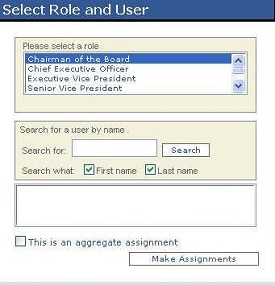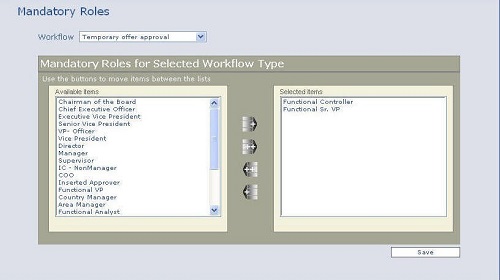- 07 Mar 2024
- 5 Minutes to read
- Print
- DarkLight
Managing Roles
- Updated on 07 Mar 2024
- 5 Minutes to read
- Print
- DarkLight
Abstract
Product: Custom Approval Workflow.
Adding, Editing, and Deleting Roles
Custom Approval Workflow workflows rely on two types of roles for approval routing:
Hierarchical roles are imported from your HRIS or other system that specifies the organizational hierarchy of the reporting relationships in your company. To see a user's place in the organizational hierarchy, see Viewing the hierarchy.
Mapped functional roles are supplemental roles that are required for approval routing. For example, if a company requires the Controller to sign off on every requisition or offer. The company's IT Manager creates a requisition for a new database engineer. As the IT Manager's hierarchy does not include the Controller, the Controller role must be mapped to the IT department so the Controller can be part of the workflow to approve this requisition. Mapped functional roles are created in Custom Approval Workflow. Functional roles can be mapped to a single organizational unit, such as a department, or to an entire organization.
Roles can be reassigned from one user to one, some, or all users.
Reassigning a role replaces the previous user with the new user in all mapped roles and approvals with the status Waiting on Me for the current user. Reassigning roles does not affect workflows that the reassigned role has already approved, but it does affect workflows for which the reassigned role is still in the approval queue.
Process
Adding, Editing, or Deleting a Role
Deleting a role does not affect running or completed workflows.
Access Custom Approval Workflow and select the Admin tab.
Select Roles → Add/ Edit/ Delete roles.
To add a role:
Select Add.
Type a descriptive name for the role in Role name.
Select Save.
To edit a role:
Select a name in the Roles list, and select Edit.
Edit the name of the role in the Role name box.
Select Save.
To delete a role:
Select a name in the Roles list, and select Delete.
A confirmation message opens. Select OK to delete the role from the system or select Cancel to leave the role unchanged.
View Role Assignments
The View Role Assignments screen is used to view all mapped functional roles for a specified user and to optionally reassign selected roles to another user.
Access Custom Approval Workflow and select the Admin tab.
Select Roles → View role assignments.
Select the workflows to view the role assignments for. By default, all workflows are selected.

Search for the user whose roles you want to view and select View Assigned Roles.
To delete a role assignment, select the user and select Delete selections.
Assigning Roles
The Assign Roles screen is used to view functional roles that are mapped to a specified organizational code combination and to assign users to those roles.
Access Custom Approval Workflow and select the Admin tab.
Select Roles → Assign roles.
Select the workflows to assign role for. By default, all workflows are selected.
Select a combination of organizational codes. Select at least one code value or wildcard option for Code1, Code2, and Code3, and up to five selections for each organizational code.
Select View Assignments.
Select a role to assign.

Search for the user to assign the role to.
Select Make assignments.
To delete a role assignment, select the user and select Delete selections.
Reassigning Specific Roles from One User to Another
Access Custom Approval Workflow and select the Admin tab.
Select Roles → View role assignments.
Select the workflows to assign the role for. By default, all workflows are selected.
Search for the user whose roles are being reassigned by using Select User to View.
Select View Assigned Roles.
Select one or more roles to reassign to another user.
Search for the user to get these roles by using Reassign Roles to User.
Select Reassign Selected Roles.
Reassigning All Roles from One User to Another
Reassigning all roles from one user for another reassigns the roles for all workflows.
Access Custom Approval Workflow and select the Admin tab.
Select Roles → Reassign user roles.
Search for the user whose roles are being reassigned by using Select Current User.
Search for the user to get all the Current User's roles by using Select New User.
Select Reassign.
Select OK to reassign the roles or select Cancel to leave the role assignments unchanged.
Defining Mandatory Roles
Mandatory roles help to ensure that minimum levels of management are included in approval routing. Mandatory roles:
Are required and cannot be removed from the approval chain in a workflow.
Apply to the entire organization for each workflow, no matter what level of the organization they are assigned to in the Assign roles screen.
Access Custom Approval Workflow and select the Admin tab.
Select Roles → Mandatory Roles.
Select a workflow by using the pull-down menu.

A list of roles for the specified workflow displays. To select adjacent items, select the first item then hold down the SHIFT key and select the last one. To select nonadjacent items, select the first one, and then hold down the CTRL key and select additional items.
To add roles to the mandatory roles list select roles in the Available Items list and select the arrow to move them to the Selected items list. To move all available roles, select the arrow to move them to the Selected items list.
To remove roles the mandatory roles list select the roles in the Selected Items list and select the arrow to move them to the Available items list. To remove all roles from a sequence, select the arrow to move them to the Available items list.
Select Save.
Defining Excluded Roles
Roles can be excluded that are not appropriate for an organization's approval routing. For example, a role might exist only in three of five business units that all use the same workflow, or the approval list for a smaller department might be more streamlined than the approval list for a larger department.
Access Custom Approval Workflow and select the Admin tab.
Select Roles → Excluded Roles.
Select the workflows to work with. By default, all workflows are selected.
Search for and select a code or a set of codes.
Select Show exclusions.
The role exclusions for the selected codes appear. The excluded roles are listed by workflow. To delete a role exclusion, select the workflow and select Delete exclusions.
Select any other roles to exclude by selecting the roles from the Select Exclusions box. Select Select All to exclude all of the roles.
Select Save.
Ranking Roles
A role's rank determines the hierarchy of approval levels when business rules are evaluated for an approval. For example, if a business rule's action is to compile all the roles up to Vice President, Custom Approval Workflow compares the current approver's role to the role ranking to determine whether another level needs to be added to the approval chain. Ranking roles is a one-time administrative setup function.
Access Custom Approval Workflow and select the Admin tab.
Select Roles → Role Rank.
Select the role to be moved in the ranking list and select the appropriate arrow to improve or reduce the rank of that role.
Select Save. To return to the Add/Edit/Delete Roles screen without saving any changes, select Manage.
Viewing the User Hierarchy
User Hierarchy displays the names and hierarchical roles of a specified user's reporting chain. The hierarchy that you see reflects the hierarchy in your organization's HRIS. You cannot edit the hierarchy.
Access Custom Approval Workflow and select the Admin tab.
Select Role → User hierarchy.
Search for and select the name of the user whose hierarchy you want to see.
Select Show Hierarchy.
